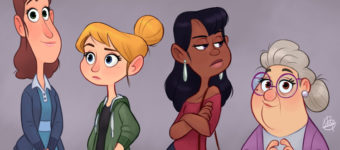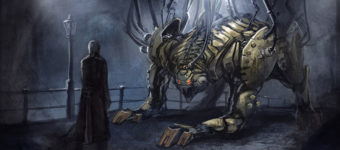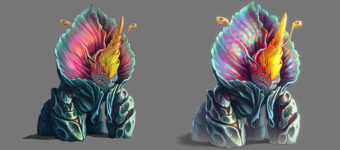
Interview with Creature Artist & CGMA Instructor Bobby Rebholz
Artist Bobby Rebholz is a master of creature design. You can see this all over his ArtStation packed with amazing and ferocious beasts.
Yet he wasn’t born with this talent and it’s something that anyone could develop with enough work.
In this interview Bobby shares his journey as an artist & how he become an instructor for the incredible CGMA.
No matter what your goals are or how long you’ve been practicing art, there’s plenty to take away from Bobby’s advice & experiences in the art world.
Can you share a little about your history with art?
I got into art at the very young age of four!
My mother would bring me to my cousin’s home for babysitting while she went to work. Both supplied me with plastic army men and dinosaurs. I would attempt to draw them every day and became obsessed with dinosaurs (what little kid isn’t?!).
I knew it was something I really wanted to do once I hit kindergarten because I was drawing on everything in the classroom.
I haven’t stopped since.
What’s your educational background and what are your thoughts on modern art education?
I have a Bachelor’s of Science in Design with a focus in transportation. Industrial design was a great way to learn the fundamentals of design.
There is a huge stigma with education costs nowadays.
Debt is soaring and online courses are becoming more popular, especially with art.
My advice is to really look at what you want.
I loved the schooling because of the camaraderie I had with like-minded people in the classroom. We pushed each other. There is a great energy you can only experience in a physical classroom setting that you can’t with online courses.
However, if you have the discipline, online courses are fantastic and can offer just as much.
There are tons of resources online for achieving virtually any skill you desire in art with a massive drop in costs for the students. Also with online courses you get access to industry veterans that you normally wouldn’t get in a physical school because of location.
Regarding your freelancing career, how did you get started with that side of art?
I’ll be honest: freelancing is hard!
Most artists don’t just fall into it and suddenly become awesome with a list of dream clients. No, it usually starts out slow and quiet with a hint of depression.
I began by being active online and in social media. I posted my work constantly and built a following that way.
I also remained active in searching for freelance gigs on several sites such as ArtStation. Even if I got turned down or didn’t hear anything back, I never took it personally and moved on.
As far as scheduling goes, freelancing can be rewarding and draining. The hours tend to be longer but you have the freedom of working whenever you want.
Discipline is your best friend… so is a calendar!
Always keep track of your clients and due dates with a calendar or some form of documentation such as spreadsheets and even Word documents.
Keep clients happy by hitting the due dates.
I admit that I’ve missed due dates from time to time but as long as I let the client know ahead of time it’s usually okay. Life happens and sometimes you need to take care of YOU, regardless of what that might be.
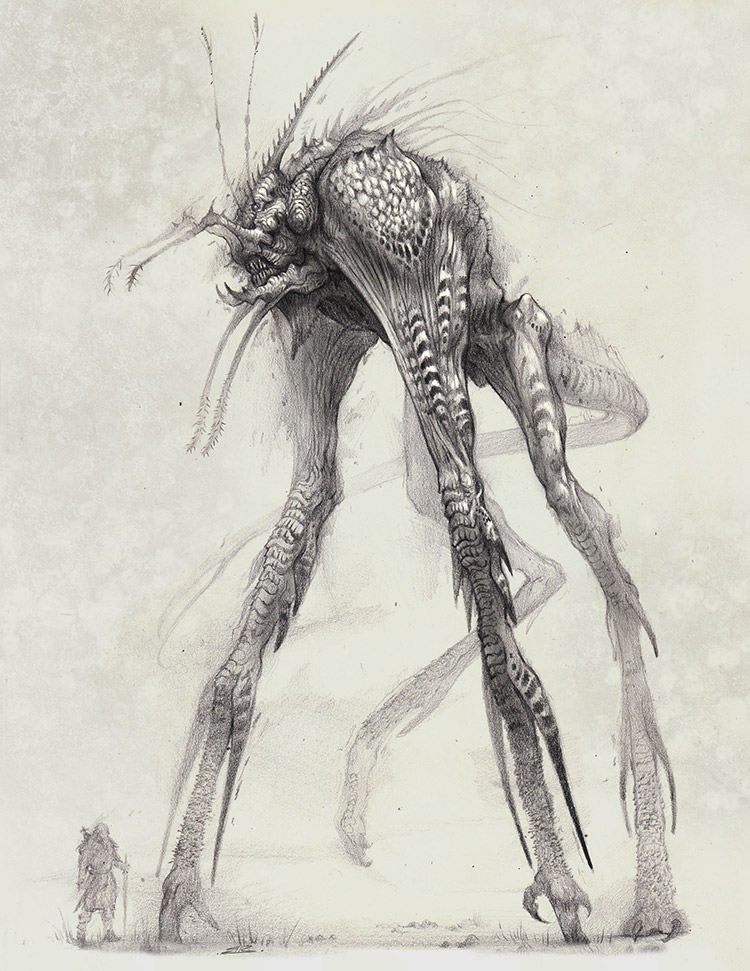
What were some of your biggest challenges while studying art & working to become a professional artist?
One of the biggest hurdles of studying art is taking criticism constructively.
Artists are stubborn. It’s our curse.
But when young artists need to improve they oftentimes take criticism personally or simply think they don’t need to improve in an area and wonder why they can’t get jobs.
This often forms in high school because you’re used to being the best in the class or school, then when serious competition hits or you’re critiqued, immediate backlash happens.
My advice is to stay humble and realize that you might suck in an area where you actually thought you were good.
Realizing this and being eager to grow is key because competition to land freelancing jobs in the real world is fierce. As Wyeth Johnson from Epic Games always says “You need to stop comparing yourself to the peers around you and start comparing yourself to the industry.”
Can you take us through a typical day-in-the-life while you’re working on projects? Any tools or software that are must-haves?
The majority of my work is pencil and paper but I also balance it with digital work.
I have Photoshop CS6 and I use a mid-sized Intuos 5 tablet.
I try to spread my projects out through day because I can’t work on only one project. Usually I do my best work in 20 minute sprints then I switch or take a break.
Going outside is key to your mental health because freelancing can be very time consuming.
I also teach in physical buildings so that helps break the cycle of staying in all day without any human interaction. I always have music on while I sketch and I make sure to keep my office clean.
Speaking of offices, it’s good to set up a designated area for you to call your office. It helps you feel more professional.
There’s no need to buy super fancy desks or filing cabinets. Instead have a comfortable chair and a nice monitor. It goes a long way.
How did you connect with CGMA and start working there as an instructor?
I actually contacted them first.
I had known about CGMA several years before messaging them. I was interested in taking an environment design course and decided to email them.
As I did that, I included a link to my portfolio.
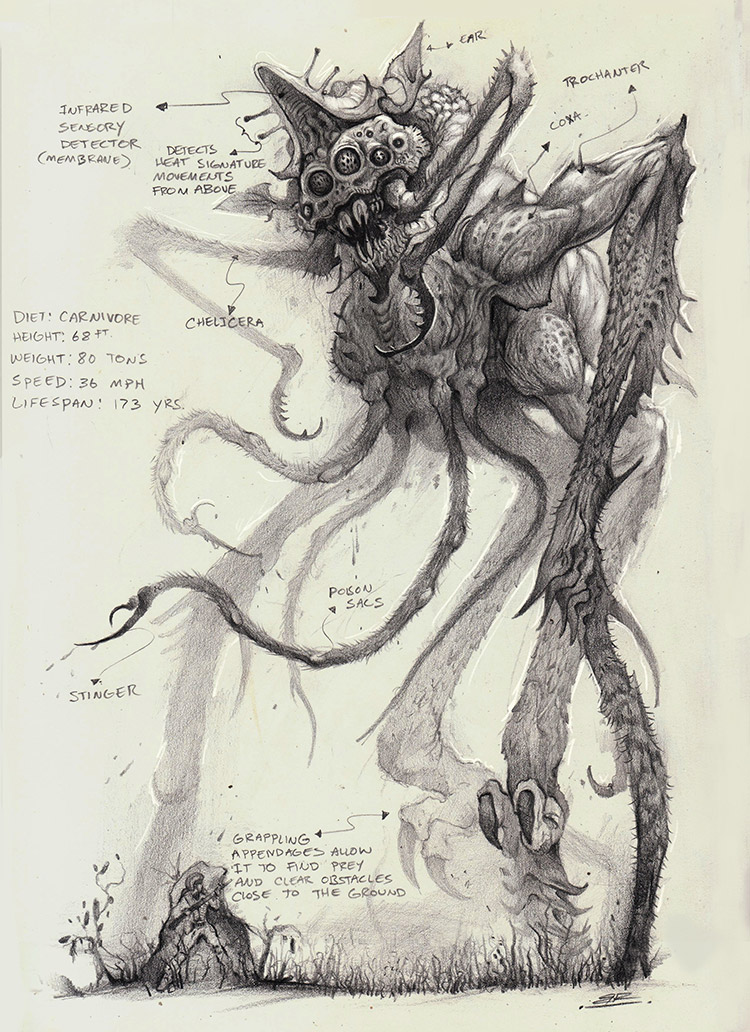
They saw that I focused in creatures and immediately asked if I was interested in teaching a creature design course for them. That’s literally how it happened!
Having years of experience teaching definitely helped in their decision to hire me. It was a cool, unexpected coincidence.
Can you share your experience working with CGMA? Any thoughts on their teaching methods & which types of students might benefit most from their classes?
CGMA does an amazing job at structuring their classrooms with assignments, lectures, live Q&As, and feedback.
Students have a lot of areas to choose from such as character design, environments, and dynamic drawing just to name a few.
It’s been a lot of fun teaching with them though because the diversity of students signing up gives you a fresh look on how people are learning art around the world.
If you’re serious about getting better and if you have good discipline then CGMA is very beneficial. The classrooms and assignments are set up much like you would experience if you were in an actual school.
How would you compare studying from a teacher online vs. studying with someone in person?
Studying from a teacher definitely has its advantages.
For example, the teacher can be there in person to correct your form as you try to draw a line or shade. We can’t do that online, but recorded videos are the next best thing.
Studying online is great because you can repeatedly watch recorded videos even after the designated class time is over. You can’t do that in an actual classroom because the teacher is gone for the rest of the day.
With both, you still get to interact with other students but a lot of times, online classrooms can affect artists who are shy.
They might never post their work for feedback whereas in an actual classroom with a teacher, they have to.
The downside to online courses is the lack of a physical presence from a teacher or student. It’s an energy that simply won’t exist online. But don’t let that deter you from your education.
Choose what you feel is the best method for you.

If someone wanted to design creatures at your level, how would you recommend they practice? Let’s assume a complete beginner wants to design awesome creatures but isn’t sure how to proceed; any thoughts or suggestions on a learning path?
First things first: Study real life animals from Earth!
Too many times, young artists think reference gathering is actually cheating.
But in reality they’re cheating themselves because the anatomy of their creatures is off. Study real animals and sketch them first.
Do this loosely without focusing on details at first. Thumbnail sketching is very important and you can do this by timing yourself at 2 minutes per sketch.
Let yourself scribble a creature shape and then stop. Look at the shape and build a creature from it.
It’s all about process and not jumping to a final design right away!
Many artists talk about the importance of drawing from life. Can you share your thoughts on why life drawing is such a crucial skill to practice?
Life drawing is important because you’re witnessing the forms live in 3D space.
You can move around the object/figure to see how perspective changes instantly.
This will get your mind accustomed to drawing the same object but in different views which is a skill in & of itself.
Concept artists work a lot from their head but also translate ideas from real life. How much should an aspiring concept artist draw from imagination vs from real life?
Reference drawing is the most important thing to focus on because imaginative drawing only happens when we pull images from our head.
Well, if you pull images from your head that are anatomically incorrect, you can make up all the art you want but in the end it’s going to be wrong.
Once you study enough reference, then you can start using your imagination and manipulate what is real and what isn’t but still have it be believable.
Being a concept artist, you must do both. But when you’re given a project you almost always start with reference gathering.
If you’re given a week to design a character or creature, spending the first two days just gathering reference is normal.
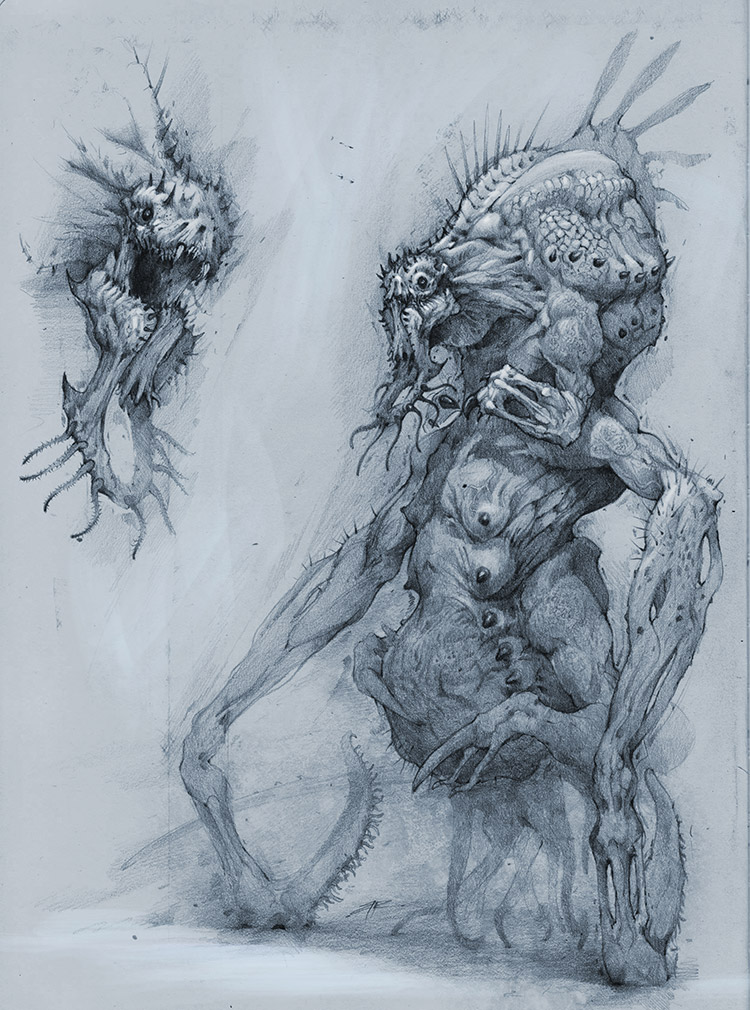
It’s never too late to learn how to draw, but life does get busier with less free time as we get older. Any tips for people who want to start practicing art later in life?
You don’t need to sit for hours every day to get better.
But it is good to at least spend 20 minutes a day practicing. No matter how hectic our lives get, we always find time for the things we love and there’s no excuses for it.
If you truly love drawing and want to improve you will find 20 minutes out of your day to do it. I know many concept artists who work normal day jobs that aren’t art related and still find time to draw during their lunch breaks.
Chris Oatley from Oatley Academy said before he became a visual development artist at Disney, he worked at Guitar Center and literally drove home during his lunch breaks to paint on canvas, then quickly drove back to work.
Any final words for all the aspiring artists out there?
Learn the fundamentals before anything else.
Clients and game companies will spot bad fundamentals in less than 10 seconds and that is no joke. It’s literally 10 seconds or less.
Just focus on what area of concept art you want to pursue. Put your time and energy into getting good in one area because your chances of getting hired will be greater.
You can practice other areas but you need focus in at least one so you become one of the best in that specific area.
A big thanks to Bobby for all of his time for this. No doubt his experience is worth listening to and if you’re looking for some online study material check out his course on CGMA.
You can find a ton of work on his ArtStation along with his social accounts like Instagram and Twitter @bobby_rebholz.


